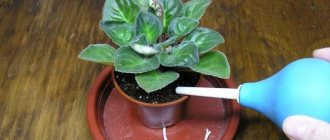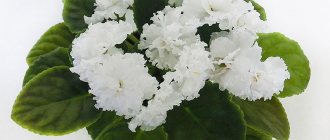Terry violet Ice Rose is a product of domestic selection. The plant is not inferior in beauty to the best foreign Saintpaulias, it amazes with its sophistication. To the rare decorativeness, you can also add the flower’s unpretentiousness in care. In this article we will take a closer look at this beautiful plant and find out under what conditions it is better to keep the Ice Rose violet.
History of the variety, decoding of the abbreviation RS. Description and features
The full name of the RS variety is Ice Rose. The first two letters are an abbreviation of the surname and name of the breeder Repkina Svetlana. It was through her efforts that this wonderful variety was developed.
The plant primarily attracts attention with its flowers. The flower of this violet, whose petals reach 7 cm in size, really resembles a rose in its outline.
The edges of the petals are bordered with green fringe. The petal itself can have shades from pink to lilac, with a wide white border along the edge.
Expert opinion
Nesterenko Ilona Mikhailovna
Florist, specialist in indoor plants. The owner of a country house with a garden and vegetable garden
Ice rose is one of the largest varieties of violets - the rosette can reach a diameter of 45 cm. The leaves, located on top of each other in several rows, have a bright green tint. Flower growers call this shade herbaceous. The edges of the leaves are wavy, the surface is quilted.
Variety RS – Ice Rose forms from 2 to 4 buds on one peduncle. Unlike other varieties, terry Saintpaulia has many petals arranged in several rows. Ordinary violets have only five petals.
Flowering is not grouped - the bud opens after the neighboring one has bloomed. The flower stalks are located directly on the leaves, bordering them with a charming wreath.
The best varieties and their characteristics
The wide variety of appearance of violets is due precisely to the fact that a lot of different varieties have been bred. It would be possible to talk about all types of African flowers only in a voluminous book. Therefore, it is advisable to focus only on the optimal varieties. “Frosty Cherry” has deservedly gained wide popularity. It produces scarlet, cherry-tinged, double-type flowers.
White fringe is found on the “Frosty Cherry”. This culture can decorate a window sill, a flower bed, and a garden. As they develop, the flowers become darker. However, a lack of light leads to their lightening. This variety is one of the heat-loving varieties, but does not tolerate excessive heat and excessive humidity.
Another variety, “Ice Rose,” contrary to its name, is not prickly at all. On the contrary, this variety is considered one of the most beautiful violets. Grace is achieved through a unique combination of white, light green and cherry paints. Corrugated fringe becomes a very bright and expressive decoration. The flower looks as luxurious as possible.
Those who want to get both attractive double flowers and an attractive aroma should choose “Chic Poppy”. Light crimson buds and other components give the impression of a ruffled dress. It seems to sway in the wind. The unique color of the foliage also adds originality to the plant (it is difficult to find another variety that would have a smooth transition between light green and dark emerald colors). You can grow “Chic Poppy” in any garden - and everywhere it becomes a real decoration.
If you ask experienced flower growers which violets are most surprising for their colors, then all or almost all will name “Isadora”. Distinguished by their splendor, semi-velvet pinkish flowers are covered with spots of a lilac hue. There are also headband ruffles. Even not very experienced gardeners will be delighted by such plants. Although Isadora is somewhat similar to peonies, she is even more beautiful than them.
An extremely original choice is the so-called “Lituanica”. Suffice it to say that this violet does not at all resemble the usual appearance of a violet.
By the appearance of the inflorescences it can easily be confused with:
- rosehip;
- dahlias;
- tea rose.
In terms of sophistication, it is difficult to name violets equal to the Rosemary variety. Delicate semi-velvet petals look more attractive thanks to purple patterns. Thanks to the wavy edges, something like a coral reef appears. The splendor and brightness of the buds makes the plant even more beautiful. During the flowering season, "Rosemary" produces 5 or 6 flowers.
Important! Plants of this variety require limited watering. Excessive irrigation is contraindicated for them.
To improve flowering, you need to take care of decent lighting. The Magenta variety may also be attractive. The dark burgundy petals surrounded by dark green foliage look simply incomparable.
A kind of “chameleon” in the world of violets is the “Grey Ocean” variety. From flowering to flowering, it turns from white to more and more blue. At the very end, you get a completely different variety of violet - “Black Pearl”. Another noteworthy violet is “Chimera”. It was not bred purposefully; the flower was obtained through accidental hybridization.
Among the violets that bloom for the longest possible time, “Darling” stands out. Delicate, maximally airy flowers are predominantly painted in light pink tones. However, sometimes they are also milky peach in color. The small size of individual colors is compensated by a significant number. By placing the plant in a relatively cool place, you can shift the balance of colors towards white.
Popular articles What diseases begonia can have - how to fight it
“Darling” is not characterized by high care requirements. It is necessary to provide only warmth and moderate moisture. And “The Country of Crimson Clouds” is distinguished by greater originality, quite consistent with the name. The flowers are a warm crimson color and have a yellow center. And around all this splendor grows dark green foliage.
Photo
Violets for the newbie!
Uzambara (Uzumbar) violet is a plant of the Gesneriaceae family, growing in the natural environment of tropical and subtropical regions of Asia, Africa, Eastern Australia, South America and the Indian Ocean islands.
Saintpaulia is a plant named after the Saint-Paul father and son, who brought a plant unknown to Europeans from the Uzambara district (modern Tanzania) in the 19th century, presented for the first time at the international flower exhibition in Ghent in 1893.
Indoor violet has been one of the most popular plants in indoor floriculture since 1927. By 1949, more than 100 varieties had been bred, and today their number exceeds several thousand.
Rooting
- possibly in water, in substrate, moss.
Priming
- purchased soil or a mixture of leaf, coniferous, turf and peat soil in a ratio of 3:1:2:1 with the addition of raising agents (perlite, vermiculite, river sand, crushed sphagnum moss.
Lighting - it is best to place flower pots on western or eastern windows. To ensure that the plant is evenly illuminated from all sides, the pots are periodically rotated. In winter, when daylight hours decrease, you can use artificial lighting - fluorescent lamps.
Caring is a real art and serious painstaking work at the same time, including watering, fertilizing, and creating a favorable humid climate. Water Saintpaulias as the soil dries. The soil must be moistened regularly, but excess moisture should not stagnate in the roots. When watering, you must ensure that water does not get on the leaves. You cannot water the Uzambara violet with cold water. Fertilizing is done with complex mineral fertilizer once every two weeks. Saintpaulia reacts negatively to a lack of nitrogen in the soil. Optimal air humidity is approximately 50%, temperature is 20-22 ° C, without sudden fluctuations and drafts. The leaves of the plant should not touch the window glass. Removal of faded flowers and damaged leaves is carried out regularly.
Reproduction - planting a leaf cutting, part of a leaf, or a daughter rosette. The most popular method is rooting leaf cuttings. The formation of roots and the development of children lasts 4-8 weeks.
Pests are one of the gardener's problems. There are many different types of pests and it is very difficult to classify them. Among Saintpaulia pests, several groups can be distinguished: mites (spider mites, flat mites, transparent mites, etc.), insects (aphids, thrips, springtails, poduras, scale insects, whiteflies, scale insects, etc.), worms (nematodes).
Diseases - distinguish between infectious (gray rot, powdery mildew) and non-infectious diseases (rotting of the stem and root, wilting of the lower leaves, yellowing, leaf spotting, incomplete opening and premature drying, falling of flowers) of plants. The causative agents of infectious diseases are bacteria, fungi, and viruses. To prevent infectious diseases, you should strictly observe the regimes of watering, temperature, humidity, and lighting. Non-communicable diseases usually arise due to poor agricultural practices. They may appear in one instance and not spread to others.
Growing rules
In order for a violet to produce many buds and ovaries every month, it is necessary to create comfortable conditions for it.
Caring for the RS variety - Ice Rose is practically no different from that of other varieties, with the exception of a couple of points.
Selecting a location
Like any violet, Ice Rose loves light very much . The northwest and northeast windows are especially suitable for growing. On a south window, violet leaves will get severe burns.
In late autumn and winter, when daylight hours are shortened, artificial lighting can be done with fluorescent lamps.
Choosing a pot
For active flowering, the pot should not be large.
Growing in a large pot, the violet spends all its energy on developing the root system.
In this case, there can be no talk of flowering. The size of the pot can be determined by dividing the measured diameter of the rosette by three.
The most suitable pot for an adult plant is 9x9. For young people, 5x5 and 7x7 pots are suitable.
Soil selection
Violet Ice Rose is most suitable for loose, breathable soil that can retain moisture well. The following composition is considered optimal:
- Chernozem soil. It is best to collect it in a forest, for example in a pine forest. This soil contains many impurities useful for violets. To disinfect, such soil is heated in the oven for an hour. Violet does not grow in black soil taken from garden beds;
- Peat taken from the upper layers;
- Vermiculite/perlite;
- Coconut fiber;
- Charcoal;
- The soil acidity required is average - from 5 to 5.5 pH.
If it is not possible to make the substrate yourself, you can purchase a special soil for violets at a flower shop.
If you collect varietal violets, we advise you to read materials about Saintpaulias “Raisin”, “Galaxy Dance” and “Chimera”.
Watering
Violet does not accept traditional watering from above. This can cause the development of diseases and rotting of leaves.
The most suitable is watering in trays or wick watering . Water should not be left in the tray for more than 15 minutes to avoid root rot.
Temperature
The most sensitive point in growing the Ice Rose variety is maintaining the desired air temperature.
With sudden changes in this indicator, the color of the petals may change.
The most comfortable indicator is considered to be +20°C. The permissible growth limit is from +18°C to +24°C.
If it is exceeded, the flowering and growth of violets may stop. For other reasons for slower development, read the material “Why violets don’t bloom.”
If the surrounding air is warmed up less than +18°C, diseases of the root system may begin due to hypothermia.
Similar care is required for other varietal violets - “Wedding Bouquet”, “Duchess” and “Royal Lace”.
Feeding
An important element is the timely application of fertilizers. Nitrogen is needed for the growth of leaves and flower stalks, and phosphorus and potassium for flowering.
To improve coloring, manganese, calcium, copper and other trace elements are needed. Ice rose responds well to the application of complex mineral fertilizers, which contain all of the above elements.
Feeding varietal violets is unacceptable at elevated temperatures in the room, especially when the leaves are exposed to direct sunlight.
Fertilizers are applied only to moist soil. This procedure is most often combined with watering. The schedule and application rates are indicated in the instructions for use of the drugs. It is important to avoid overdose - this can have a detrimental effect on the plant.
Features of caring for the violet RS Ice Rose at home
Among other violets, this variety is quite unpretentious, but it also requires certain conditions for good growth. Regular watering, like many other plants, will not be enough for this beauty.
- Temperature
Violet Esmeralda - description and characteristics of the variety
The optimal growing temperature is +18..+24 °C. The cooler the room, the lighter the petals.
- Lighting
Lighting is a very important part of violet care. In summer, natural light from the streets is sufficient, but in other seasons, additional lighting will be needed. Therefore, a novice breeder of these flowers will need to purchase a fluorescent or special phyto-lamp.
Important! In summer, you should not place the plant on the windowsills of south-facing windows, it will be too hot there and it is possible that the delicate leaves will get sunburned. North-west or north-east are ideal.
- Watering
Water for irrigation should be warm and soft enough. If top watering is carried out, then you need to ensure that droplets of water do not fall on the leaves or flowers. This will increase the risk of disease.
The best option is wick watering. Watering through a tray is also possible. In this case, the plant absorbs as much water as it needs. The risk of root and other types of rot is reduced.
Wick watering of violets
- Spraying
Spraying this hybrid violet is completely contraindicated.
- Humidity
The minimum level of air humidity in the room is 50%.
Too dry air will have a bad effect on the development of the flower. Therefore, next to the violets you can place a cup of water, damp moss, or purchase a special humidifier. This is especially important in winter, when the central heating radiators are turned on.
- Priming
The soil should be nutritious, very light and loose. It should allow water and air to pass through well. Even when purchasing a ready-made substrate for Saintpaulia, it is worth checking whether perlite is present in it. If it is not there, you should add either this baking powder or sand.
You can always add dolomite flour, moss, and crushed eggshells to any soil for violets. A neutral acidity level is preferred.
- Feeding
During the first 6 months after transplantation, no feeding is required. They are then applied according to life stage.
At the very beginning of the growing season, nitrogenous fertilizers are applied, which stimulate the active growth of the green part. During the flowering period, potassium-phosphorus fertilizers are applied, which promote more luxuriant flowering.
Important! Fertilizing is done in conjunction with watering. If watering is wick, then fertilizers are applied directly to the water.
Reproduction
Varietal characteristics are preserved only if violets are propagated by cuttings and peduncles.
For propagation, the healthiest and strongest one is selected from the second row of rosette leaves.
It is placed in a glass of warm boiled water.
When the root system grows 1 cm, this cutting is planted in the prepared substrate.
Can be planted directly into the ground. The cuttings are buried a third of their length. This will facilitate the development of the root system and the appearance of lateral shoots - children. To avoid excessive evaporation of moisture, while the root system is not sufficiently developed, seedlings are kept in greenhouse conditions.
To do this, containers with leaves are covered with plastic wrap or a glass jar. To remove excess condensation, ventilation is carried out in the evenings.
To prevent the seedlings from drying out, moderate watering is carried out.
Expert opinion
Nesterova Olga Nikolaevna
Specialist in landscaping, master of landscape design. Indoor floriculture consultant
The best method for propagating varietal violets is considered to be growing a new plant from a peduncle. Only a healthy peduncle is selected. It is broken off at the base and planted in a small container with prepared soil. It is necessary to deepen it to two-thirds of the length of the peduncle.
Further care is no different from caring for seedlings from cuttings. For other ways to obtain a new plant, read the material “Methods of propagating violets.”
Transplantation after purchase and during reproduction
After purchasing a violet, you should not replant it immediately. It must go through the incubation period in the same container in which it grew in the store.
Attention! For 14 days, the plant should be protected from the rest; it is advisable to place it in a separate room. This is necessary in order to protect home flowers from diseases and parasites that Saintpaulia can bring with it.
Further transplantation is carried out by transshipment. Transplantation to a new place is carried out once every 2 years, more often, but not less often. The size of the pot should increase slightly each time, but it should not be too deep.
In a large pot, the growth of the plant will slow down, since it will be absorbed primarily by building up the root system. Only after it has entwined the earthen lump will the ground part begin to develop.
Transplanting violets
How to form a bush correctly
As the Ice Rose variety ages, not only does the rosette grow, but the central trunk also lengthens, the flowers become smaller and are externally separated from the leaves. Stepchildren are growing.
All this leads to the flower losing its shape and former attractiveness.
To prevent this from happening, you need to carry out the rejuvenation procedure on time . To do this, the upper part of the rosette is cut off and rooted in water or soil. When a new root system grows, the violet is transplanted into new soil.
If the violet is not yet that old, the rejuvenation procedure includes the following measures :
- Removing faded buds.
- Removing old and missing leaves. Often, when the rest are growing well, all the lower leaves are cut off.
- Removal of lateral processes - stepsons.
- For uniform growth of a flower, it is periodically necessary to change its place of growth or about once a month to turn it with different sides to the sun.
Have you noticed insects on your plants? Then the material about pests of indoor Saintpaulias will be useful to you.[/link_webnavoz
When and how does Ice Rose bloom?
Violet Blue Mist - description and characteristics of the variety
The flowering of this variety is quite lush and long-lasting. The flowers are double, with fringed edges, fantasy in color.
The shape of the flowers is densely double Pansy.
The flowering period can last up to 10 months, followed by a short break. The variety begins flowering at 9 months of age.
Changes in care during the flowering period
No special changes in care are required. It is important to remove dried buds in a timely manner. Fertilizing with complex fertilizers is carried out 2 times a month.
Interesting information about the variety
The dependence of the shape and color of flowers on the ambient temperature is very interesting.
At +20°C there are no cherry spots on the flower petals.
They remain white with green fringe around the edges.
When this indicator increases to +26°C, the cherry color begins to predominate, and the green edging disappears completely.
Each new flowering remains unpredictable, which gives the opportunity to experiment with coloring.
Not always during reproduction, children grown by the cutting method can inherit the characteristics of the mother violet. The resulting Ice Rose has an uncharacteristic color of a different color with a constant green fringe along the edges.
Breeders call such violets sports . In sports, the buds are more developed, flowering takes longer, but they are not suitable for further reproduction.
In their beauty, sports are not inferior to mother plants and can become a worthy addition to a gardener’s collection.
Reviews
There are not many reviews about this plant on the Internet: after all, the variety was bred not so long ago. However, the most inquisitive gardeners have already tried to grow this violet and are sharing their impressions. They note the external beauty of the plant, its spectacular, decorative appearance, the splendor of both rosettes and buds.
Among the disadvantages, some note the unpredictability of the color of the petals: the tone of the buds greatly depends on the surrounding temperature. To get the most beautiful and richly colored buds, I advise you to grow Saintpaulia ice rose at a temperature of +26 degrees.
We met a unique variety of violet, ice rose. This flower was bred in our country and is adapted to soil, air, and not too high temperatures. Violet is not difficult to grow, and its decorative value is beyond praise.
What can harm varietal Saintpaulia
Varietal violets are most susceptible to pests.
- Ticks These pests cannot be seen with the naked eye. They settle on aging leaves. Their vital activity is characterized by the appearance of white dots on the leaves. For prevention, these sheets need to be cut off.
- Thrips . Insects, which can only be seen under a microscope, can fly. Indoor plants usually end up with pollen from outdoor plants and poplar fluff.
- Aphid . The activity of these insects is detrimental to violets. Characterized by the appearance of cobwebs on the leaves. Later they turn yellow and disappear.
To combat insect pests, there are special preparations - insecticides, which are sold in specialized stores.
Despite the “cooling” name, the appearance of the violet variety RS - Ice Rose evokes warm emotions. With proper care, the violet will reciprocate and bloom with new buds for many years.
Pests
The violet can be attacked by harmful insects that are not averse to feasting on the leaves and juices of the plant. Let's get acquainted with the most dangerous pests for Saintpaulia ice rose.
Spider mite
A very small insect that leaves behind barely noticeable white webs on the foliage. Pests are removed manually, and if there are many of them, the flower is treated with insecticide.
Thrips
Miniature parasites that can fly from flower to flower. Therefore, when a violet is infected with thrips, the first thing to do is immediately isolate the diseased plant from other indoor flowers. Treatment is carried out only with an insecticide: Fitoverm is optimal.
Aphid
Often this pest gets onto violets from cut flowers brought from the street. To prevent infection, do not place a vase with a cut bouquet close to a pot of Saintpaulia. And to cope with aphids, you will need several insecticidal treatments.
Keep in mind that when spraying, be sure to turn the leaves and treat their undersides. Aphids settle in such secluded places.
Care instructions
Caring for Saintpaulia LE-Rose of the Winds includes watering, fertilizing and replanting the plant.
Watering
It is recommended to water the flower only at the root, avoiding water droplets getting on the leaves. This is due to the fleecy structure of the leaf plates, due to which water does not evaporate for a long time and does not flow from the surface of the leaf, causing it to rot.
If this is not possible, then you can water with tap water that has been pre-settled for two days. Wick watering gives good results, allowing the plant to take exactly as much moisture as it currently needs.
This method is carried out using a rope:
- a rope made of natural fibers 2 mm thick is passed through the substrate into the drain hole of the pot;
- The pot is placed on a jar of water, and the end coming out of the hole is lowered into the water.
Fertilizer
It is recommended to feed the LE-Rose of the Winds violet with special additives for Saintpaulias. The procedure is carried out in the spring and summer months - once every two weeks, and in the fall - once a month.
For two weeks after transplantation, as well as during illness, feeding Saintpaulia is prohibited. As for the type of fertilizers, when growing green mass, the main emphasis is on nitrogen-containing preparations, while flowering plants require additives based on phosphorus and potassium.
Transfer
Planned transplantation of adult Saintpaulias is carried out once a year in the spring. However, if the roots rot or a whitish coating forms on the surface of the substrate, an emergency transplant is allowed. The need for regular replanting is dictated by the acidification of the old soil, which can provoke disease and then the death of the violet.
The essence of the procedure is as follows:
- 2 cm of expanded clay is placed in a pot of slightly larger volume than the one being used and the prepared substrate or purchased mixture is poured on top;
- the container is filled with soil to 1/3 of the total volume, after which the plant is placed in the middle and the voids are carefully filled;
- then the soil around the flower is compacted and watered moderately.
Transplanting an adult plant
It is recommended to replant violets older than 1 year once every two years. Planned replanting is carried out to replace depleted soil with fresh and nutritious soil. Within a year or two, the soil in the pot is not only depleted, but also caked. Looseness is lost, air exchange deteriorates, and the root system does not receive enough oxygen. The flower is moved before watering. Dried substrate is easier to shake off the roots. The lower part of the root system is cut off, and several lower leaves are also removed.
For an adult plant, you do not need to take a pot of a larger diameter; after removing the roots, it will fit in a container of the usual size. The substrate should be loose and moist, the soil should be poured up to the lower leaves. There is no need to compact it. Growing roots need a lot of air
For the first two weeks, water the plant with extreme caution, trying not to over-water it. You can put it in a greenhouse. In a month, the violet will take root in a new place and produce new leaves and flower stalks.
In a month, the violet will take root in a new place and produce new leaves and flower stalks.
Measures for caring for indoor flowers include disease prevention. They must be inspected regularly and dry leaves removed. New violets must be quarantined for a month. Pests can enter the premises from the street: spider mites, thrips. To combat them, special drugs are used.
The Ice Rose violet can often be seen at exhibitions. It attracts visitors with its unusually beautiful double flowers. Having bought a leaf or a baby from a varietal plant, you can grow a luxurious Saintpaulia yourself to decorate your interior.
Unanswered messages | Active topics
| List of forums » Violets » Standard violets » Repkina S. Current time: Sun Dec 30, 2022 06:02 |
| List of forums » Violets » Standard violets » Repkina S. Current time: Sun Dec 30, 2022 06:02 |
| This forum is currently viewed by: no registered users and guests: 0 |
| You cannot start topics You cannot reply to messages You cannot edit your messages You cannot delete your messages You cannot add attachments |
Ice rose loves diffused sunlight, preferring eastern or south-eastern window sills so that there is a lot of light, but direct sunlight does not leave burns on its leaves. On the northern side, with a clear lack of light, flowering will be more than modest. The only way out is to organize additional lighting. You need to choose a lamp with white cold light and place it at a height of 20 cm above the plant. The same thing will have to be done in winter if you want to admire the blooms all year round, because if there is a lack of light, the violet will not please you with flowers.
Violets feel normal at temperatures from +16 to +28 degrees, but to bloom they need a range from +20 to +26 degrees. When the air temperature is too low, they stop growing, and in extreme heat they begin to dry out or wither.
Plants should be watered as needed, when the top third of the soil dries out. The frequency of watering depends on the time of year, air temperature, age of the violets, and the size of the pot, so it is better to check the condition of the soil. For irrigation, use only soft, clean water no cooler than the air, maybe even a couple of degrees warmer.
For comfortable growth of Saintpaulia, an air humidity of at least 50–60% is needed. In extreme heat or when heating devices are on, the humidity around the plant is increased using a tray with wet pebbles or moss, on which a pot with a stand is placed. You can simply hang a wet towel on a nearby central heating radiator or spray the air around the flower so that the droplets do not fall on it.
The Ice Rose is replanted after 2 years using the transshipment method, being careful not to damage the roots. The pot can be made of any material, its size is important. If it is too large, the roots will grow intensively, but the violet will not bloom, and there will always be a risk of soil acidification. If the roots hit the walls and entwine the entire earthen ball, they won’t like it either. Usually the pot is chosen so that the leaves, after planting, extend half beyond its boundaries.
The soil should be slightly acidic, fertile and breathable. You can buy a universal one, and then add soil from under coniferous trees, coconut fiber or sphagnum moss, and crushed pine bark to it. You can buy soil for violets, but add more vermiculite to it for greater looseness.
Ice Rose responds well to feeding with Kemira Lux, but it needs to be diluted twice as much as indicated in the instructions.
Transplanting an adult plant
It is recommended to replant violets older than 1 year once every two years. Planned replanting is carried out to replace depleted soil with fresh and nutritious soil. Within a year or two, the soil in the pot is not only depleted, but also caked. Looseness is lost, air exchange deteriorates, and the root system does not receive enough oxygen. The flower is moved before watering. Dried substrate is easier to shake off the roots. The lower part of the root system is cut off, and several lower leaves are also removed.
For an adult plant, you do not need to take a pot of a larger diameter; after removing the roots, it will fit in a container of the usual size. The substrate should be loose and moist, the soil should be poured up to the lower leaves. There is no need to compact it. Growing roots need a lot of air
For the first two weeks, water the plant with extreme caution, trying not to over-water it. You can put it in a greenhouse
In a month, the violet will take root in a new place and produce new leaves and flower stalks.
Measures for caring for indoor flowers include disease prevention. They must be inspected regularly and dry leaves removed. New violets must be quarantined for a month. Pests can enter the premises from the street: spider mites, thrips. To combat them, special drugs are used.
The Ice Rose violet can often be seen at exhibitions. It attracts visitors with its unusually beautiful double flowers. Having bought a leaf or a baby from a varietal plant, you can grow a luxurious Saintpaulia yourself to decorate your interior.
My window sill was not spared summer surprises either. The color of some varieties has changed, not to mention the size of the flowers. But first I’ll show you photos of the most persistent ones. RS-Ghost:
Huge (7cm), semi-double and double, voluminous, corrugated white flowers with a blue eye and blue streaks. Medium green, wavy foliage.
This is my all time love! It doesn’t mind the summer heat, it blooms willingly and with a decent head of flowers, and the size of the flowers doesn’t suffer either. The only difference from winter flowering is that it becomes more blue, but judging by the breeder’s description, everything is within the variety. My outlet turned out to be a decent size, now I’m raising a couple of children on a “starvation” diet, maybe this will help.
A few closer portraits of the Phantom:
Flower size:
The following variety, which can be classified as “persistent”, is RS-Ice Rose:
From the description: Very large semi-double and double white flowers with cherry strokes and a light green fringe along the edge of the corrugated petals are very impressive and original against the background of medium green wavy foliage.
The rosette blooms for the second time. The first winter flowering produced only one peduncle, but the flowers were exactly the same. We haven’t grown a gorgeous cap yet, and I would like the flowers to be more double, but the presence of a green border in the very heat cannot but please. I will wait for the next flowering, but for now this is what is closer:
The buds, such heads of cabbage, are not inferior in beauty to flowers:
But the following varieties are included in a large group of very similar varieties, and choosing the most worthy of them is not an easy task.
RS-Cabaret. A gorgeous bouquet of semi-double, ruffled dark fuchsia flowers with white edges and a white eye harmonizes perfectly with the medium green pointed foliage.
Everything in this variety seems to be in place, but somehow it’s not memorable, it’s not recognizable at first sight! Summer flowering from winter, according to my observations, is not very different.
PC-Magic Carmen. Huge semi-double fuchsia-raspberry flowers with a deep red center and white wavy edges of the petals.
But this variety gave me a surprise! The photo shows summer flowering. In winter, this variety was more like RS-Cabaret, only the border was clear and there was no corrugated edge. And in the summer such beauty blossomed. Delicate and touching, lighter than in winter, the flowers attracted my gaze. I can associate the change in a lighter direction with the fact that the outlet was on the windowsill (lots of light) and it was high time to replant it, the soil was depleted. I liked this flowering option much better.
Closer acquaintance:
These are my summer flowers!!!
How to propagate at home
To preserve varietal characteristics, propagation is best carried out by separating daughter rosettes.
This is usually done when replanting a plant in spring or autumn:
- The blade separates the daughter rosette.
- The sprout is planted in a peat briquette.
- A month later, when the bush is well rooted, it is transplanted into a pot.
Another method is propagation by leaves, which is traditional for violets. As mentioned above, this method is undesirable for the Wind Rose, as this often leads to a loss in the quality of the flowers. If the grower nevertheless decides to propagate violets using this method, you need to select the strongest leaves from the second tier above the soil - they are cut with a blade at an angle of 45° and placed in peat, a soft non-acidic substrate, or simply in settled water. After 30–45 days, the plant will be ready to plant in a pot.
Violet RM-Roses in Crystal
The bright standard Saintpaulia is a relative novelty - registered in 2022.
Wonderful violet Rose in Crystal.
Designation of decorative features
A feature of the variety is that the young rosette has small gaps between the leaf plates - the result of the elongation of the petioles of the first leaves. Adult bushes themselves correct this defect and gradually form a rosette of almost ideal shape.
Violet leaves are different:
- Large dimensions, bright, emerald-colored veining pattern;
- Juicy green shades of summer foliage;
- Quilted surface with glossy texture;
- And large, wavy teeth.
The lateral edges of the leaves certainly have a wavy texture.
The flowers are characterized by a large diameter, their shape partly represents the type of “stars” that do not fully open, with terry filling of wavy petals.
The edges of each petal bear a very ruffled fringe, highlighted with greenish colors. The tonality of the corolla itself is represented by a white color scheme with blue flashes.
A characteristic feature that gives a special grace to the violet is the inability of some flowers to open completely. They freeze in their development at a certain stage, turning into something like small heads of cabbage.
NOTABLE! It is this feature that makes the violet look like the dense buds of peony roses, and it is also responsible for the name of the variety.
The violet in question looks like a rose.
The originality of growth in the room
Violet is not picky at all, but you should pay special attention to some nuances in its life activity. The variety develops quickly, blooms in multi-colored clusters
You need to carefully monitor the microclimate - the variety requires cool conditions to maintain the special shape of the flowers:
- With a lower temperature gradient, flowers will be able to form unopened “heads” - and this is very impressive;
- In cool conditions, the color of the green ruffle appears much brighter.











